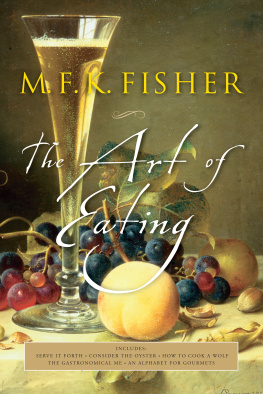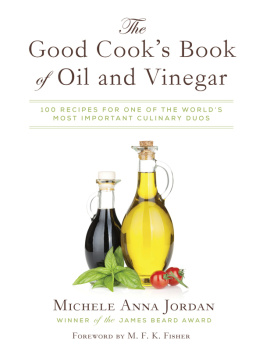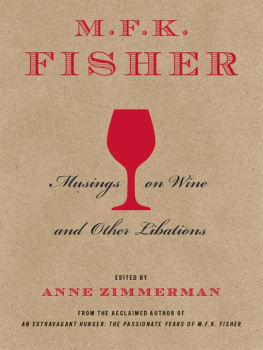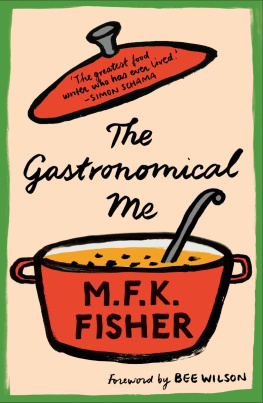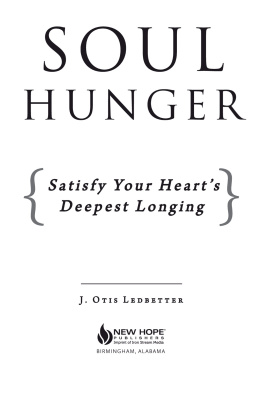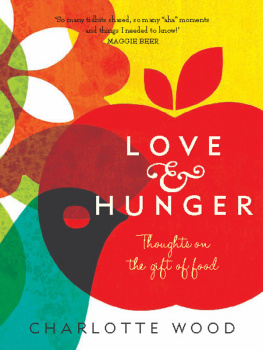Copyright 1937, 1941, 1942, 1943, 1948, 1949, 1954, 1990, 2004 by M. F. K. Fisher. All rights reserved.
Published by Houghton Mifflin Harcourt Publishing Company
A compilation of the works of M. F. K. Fisher first published in book form separately under the titles: Serve It Forth; Consider the Oyster; How to Cook a Wolf; The Gastronomical Me; and An Alphabet for Gourmets.
For information about permission to reproduce selections from this book, write to Permissions, Houghton Mifflin Harcourt Publishing Company, 215 Park Avenue South, New York, New York 10003.
www.hmhco.com
Trademarks: Houghton Mifflin Harcourt and the Houghton Mifflin Harcourt Publishing logo are trademarks of Houghton Mifflin Harcourt Publishing Company and/or its affiliates. All other trademarks are the property of their respective owners. Houghton Mifflin Harcourt, is not associated with any product or vendor mentioned in this book.
The Library of Congress has cataloged the print edition as follows:
Fisher, M. F. K. (Mary Frances Kennedy), 1908
The art of eating / by M. F. K. Fisher ; with an introduction by Clifton Fadiman, an appreciation by James Beard, and a biographical essay by Joan Reardon.50th anniversary ed.
p. cm.
Includes index.
ISBN-10: 0-7645-4261-3 (paperback : acid-free paper)
ISBN-13: 978-0-7645-4261-9 (paperback : acid-free paper)
1. Gastronomy. I. Title.
TX633.F515 2004
641.013dc22
2003026124
e ISBN 978-0-544-17743-7
v1.0514

The Art of Eating: In Celebration
D URING HER LIFETIME M. F. K. Fisher was no stranger to introductions. She wrote them for well-known authors and for community cookbooks and for friends and fansor she dashed one off because the subject of the book interested her. During her fallow periods she welcomed requests to introduce books on tea, on wine, on Japanese cooking, and on road food simply to keep her name in the mainstream of gastronomical publishing. Fisher also introduced her own books with clarifying forewords although she seldom warmed to introductions to her work penned by others. In a letter to Esquires Arnold Gingrich, she indicated that she found [W. H.] Audens little essay [for The Art of Eating very wandering and foggy. She even revisited the introductions she had written, and revisionist that she was, she reintroduced the introductions and conclusions and forewords and afterwords to her major works in the slender volume called Dubious Honors.
So, is another introduction to M. F. K. Fisher necessary? Yes, because celebrating the 50th anniversary of the publication of The Art of Eating mandates placing this seminal work into the context of twenty-first century gastronomy.
The volume heralded in 1954 as the Collected Gastronomical Works of M.F.K. Fisher has not only been in continuous print for fifty years, but it has also become a benchmark for all that is original and memorable in Americas culinary writing during the first half of the twentieth century. Fisher brought to the nutrition-oriented and commercial-centered culinary landscape a fresh vision, and she was uniquely positioned to do so. Exposed to French wines and food and steeped in the rich tradition of Continental gastronomical writing while studying in Dijon in the early 1930s, nurtured in the California tradition of fresh and seasonal ingredients, mentored by a succession of variously trained cooks in her familys kitchen, and more than a little intrigued by the language and lore of culinary history, Fisher found the perfect medium to display her journalistic skill, a legacy from her father and grandfather, and, as James Beard said, her deeply personal thoughts and experiences that resound in ones emotions. And in each book, beginning with Serve It Forth in 1937, Fisher became more adept at creating her glorious mix of subjectivity and history, legend and lore.
Fisher said of her first book, Serve It Forth, It will be about eating and about what to eat and about people who eat. And I shall do gymnastics by trying to fall between the three fires, or by straddling them all. The book ranges from Egypt, the Orient, and Greece (3000 B.C .100 A.D .) to twentieth-century America in a sequence of vignettes highlighting amusing and sober events in the history of food. Woven among the historical essays are personal tales of secret indulgences, restaurants visited, two friendly recipes, and Fishers thoughts about an ideal kitchen. The focus of each piece is foodtangerines toasting on a radiator, a perfect waiter spilling the soup, the smell of cabbage denoting class distinction, steak as a masculine prerogative, and diplomate au kirsch at a Sunday family feast. Overlaid with multiple connotations, food becomes a metaphor for our basic human hungers.
In Consider The Oyster (1941), Fisher ranged more freely, adding the fascinating maritime habits and scientific information of the bisexual bivalve to the aphrodisiac lore and personalities famous for generating the legends defining the oyster. From Antoines in New Orleans to a tavern in Connecticut, she collected those recipes that traditionally attracted the aficionados of both raw and cooked preparations. She also drew on fond memories of childhood Sunday suppers of comforting oyster stew, and her mothers reminiscences of boarding school oyster loaves. The result was less studied than her first book and an interesting blend of facts and personal experiences. That she wrote it to distract her second husband, Dillwyn Parrish, from the debilitating pain of Buergers disease accounts for the wit and lighthearted tone that permeates the book; but she was also sharing stories, memories of stories told to her, and recipes the same way she would share a tureen of oyster stew, ladling out a lusty bit of nourishment.
The progress of World War II in Europe, the tragedy of Dillwyn Parrishs illness and death, and the advent of Americas involvement in war with the Axis powers mandated Fishers third book be aptly called How To Cook A Wolf. Having seen blackout curtains, and experienced food shortages and curfews in Switzerland, she was in a unique position to recommend strategies for Americans intent on living agreeably in a world of constraints. Published in 1942 when shortages and rationing were rampant, she used what was a dire but temporary situation to discuss current fallacies regarding what people should eat, singling out the balanced meals touted by popular home and garden magazines for particular criticism. Every chapter in this book is a how-to guide. How to: Greet the Spring, Be Sage Without Hemlock, Keep Alive, Rise Up Like New Bread, Be Cheerful Though Starving, and Be Content with a Vegetable Love. And there are a few How Not to... chapters as well. She proposes breakfasts of heaps of toast, an all-vegetable lunch of soup or salad, steak or a cheese souffl for dinner, and juice or fruit for a between-meal pick-up. If the entire day, rather than each meal, balances out nutritionally, fine. The important thing is awakening the palate to the pleasures at hand whether they be starches or proteins. She draws on memories of her mothers gingerbread, French food, and canned foods and arranges the seventy-three recipes into traditional categories like appetizers, egg dishes, poultry, meat, and desserts, adding, with a wink and a nod, tips to ensure the survival of the dog Butch and cat Blackberry during wartime shortages.
The centerpiece of The Art of Eating, and the most oblique book in the collection, is the autobiographical The Gastronomical Me (1943). Written during her first pregnancy, Fisher used memorable meals and food experiences to tell her own story and assess her career before she assumed the role of a single mother. The people she wrote about were with me then, [with] their other deeper needs of love and happinessGrandmother Holbrook making jam in the Whittier kitchen; her father Rex and sister Anne dining on fresh peach pie and thick cream by a stream when the three drove home from her aunts ranch; her first husband Al Fisher and Mary Frances celebrating their first-month anniversary at the Aux Trois Faison restaurant in Dijon; Dillwyn and she returning to the States on the
Next page
